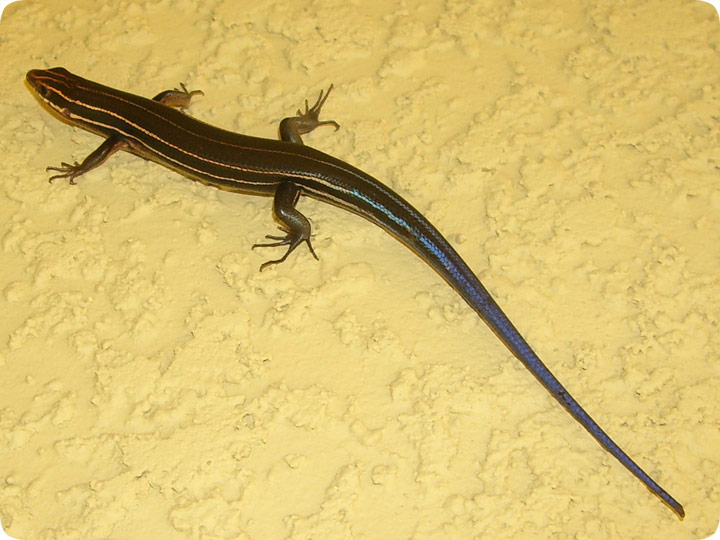-
info@aaanimalcontrol.com
Call us for help in your town
Humane Wildlife Education
Five Lined Skink

06.22.2003 - The Five Lined Skink, (Eumeces fasciatus), also known as the Blue Tail Skink, is a small lizard that lives throughout much of the eastern United States. Skinks are characterized by a lack of neck, a smooth tubular body, and short
legs. They squiggle along when they move. As either of their common names imply, this lizard has five bright lines tracing down its back and tail, and the tail is blue. The colors are more pronounced in younger lizards, and can fade with age, particularly in
the male lizards. I think this lizard is very pretty. It has the sort of fancy colours more commonly associated with tropical fish. While I spot this lizard from time to time, perhaps 2-3 sightings per year, it is far less common than other small lizards, such
as the Green Anole. This lizard certainly does not pose any threat or problem to people, and of course I've never received a call to remove one - though I wouldn't put this past some people, who
unnecessarily hate all reptiles. If you see this colorful little
lizard, consider it a treat!
Do it yourself: Visit my How To Get Rid of Lizards page for tips and advice.
Get professional help: Visit my Nationwide Pro Directory of wildlife removal experts.
For more wildlife stories, click my Wildlife Blog
or click my below banner to hire a local trapper.
Like other reptiles, even lizards will have a different family specie that is unfamiliar to most people. One of those is the five-lined skink, which is basically like your common house lizard but with five distinctive stripes that run along the length of their bodies.
Unlike the common household reptile, they are often found in moist forested areas where they can hide in a variety of places such as rocks, crevices, or within wood and leaf debris. These locations also offer great open areas for basking in the sun.
Appearance
As mentioned, the five-lined skink is known mainly for the five stripes that run down from their nose to their tails –usually in the color yellow or white. The rest of their body, on the other hand, is common in the colors brown, black, or olive.
The older the lizard gets, the lighter their colors appear. For males, their stripes might even start to fade as well. Compared to the female skinks, males usually have larger heads and an orange coloring on their snouts which is developed during the mating season.
In length, they range from 5 to 8.5 inches long –which is much bigger than the usual house lizard.
Diet
The five-lined skink is generally an insectivore. Their regular diet consists of a variety of wild insects like spiders, millipedes, termites, grasshoppers, caterpillars, beetles, and other similar bugs.
At times, they will also consume snails or small vertebrae such as frogs, smaller lizards, and even newborn or small mice.
Life Cycle
A skink typically chooses large decaying stumps or logs found in moist areas to use as their nests. They commonly put other nests together to allow the female skinks to communally care for and defend each other's eggs.
During their mating season, a female skink can lay up to 15 eggs –each that are half an inch long with a thin paper-like shell. These eggs will first appear as white and later become more mottled and larger the longer it stays in contact with the nest and absorbs the water.
The shortest incubation period, which is during warmer weather, is about 24 days. When it's colder, the incubation can last up to nearly two months. After a few days of hatching, the young will leave the nest and later be able to live on their own without the guidance of their parents.
Behavior
Skinks aren't nocturnal, which is why they are most active during the day and take shelter and rest during the night time. They reside in protected areas especially before winter starts to keep themselves warm and protected from predators.
Male skinks will actively defend their own territories against other male skinks. This is mainly because of their solitary nature. However, the female skinks will often cooperate with each other when it comes to protecting and guarding their eggs.




















